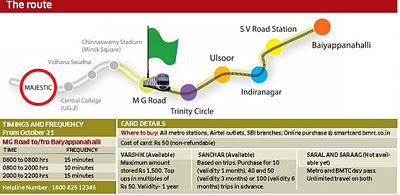Bangalore for long had wanted the Metro. It started smoothly and later went on a rough patch. With 3 deadlines finally passed reach -1 of Phase-1 was opened for public on Oct 20th 2011. It is 3rd in the country to have a system of this kind and on par with international standards as far as tracks, coaches, signalling is concerned. The excitement that was visible when Delhi metro first started was similarly visible even in Bangalore. I still remember when I boarded the first metro of Delhi - the red line - I was wondering if I was indeed in India !!!
Bangalore Metro is South India's first metro. This has made the people of Chennai, Mumbai and Hyderabad even more restless and are eagerly waiting for their own metros to be completed.
If the excitement and the way people thronged the stations is an indication of anything then it is the rising expectations of the people who are desperate to see how the other parts of the Metro completely finish without missing deadlines.
The stops, the frequency, timings are given below:
The fares are as below:
However, some of the salient features include:
Flip side:
Train frequency is 15 min (it will be reduced eventually depending upon the demand)
Metro will not reduce traffic congestion drastically (may be 10-20% reduction) and it is too much to expect that given the fact that Delhi, London, Tokyo continue to experience traffic issues and overcrowded trains
At least until the metro is completely over one cannot expect any changes.
Pic courtesy" skyscrapercity, google, youtube, timesofIndia
Feeder buses:
The places where feeder buses serve is in the chart below:
There are lots of questions which can be answered slowly over time. Will Metro be maintained clean? Will there be sufficient patrol of it like in the Delhi Metro? How frequently will the train develop technical snags? Will the escalators work all the time and if it needs maintenance how quickly will be repaired? Will the feeder buses which pick up and drop to nearby areas work correctly and effectively?
Bangalore Metro is South India's first metro. This has made the people of Chennai, Mumbai and Hyderabad even more restless and are eagerly waiting for their own metros to be completed.
If the excitement and the way people thronged the stations is an indication of anything then it is the rising expectations of the people who are desperate to see how the other parts of the Metro completely finish without missing deadlines.
The stops, the frequency, timings are given below:
The fares are as below:
However, some of the salient features include:
- Improved sign boards and clear display of information at the station and inside the train.
- Stainless steel coaches and ballastless tracks(used in high speed trains in China and Japan which require less maintenance) .
- Can sense another train, if any, on the same track and automatically stop at a safe distance. (Wonder why Indian Railways cannot adopt this?)
- Wi-fi connectivity in the stations and inside the train (not available in Delhi or Kolkata metro).
- Disabled friendly ramp
- 7 km journey in 12-14 minutes
- The ticket system is either through SMART CARDS or SMART TOKENS which are different from each other. They can be refilled through ATM's, mobile banking, net banking. I feel this is the best feature because it is very efficient and user friendly.
- Of course the common features like using a preloaded card is also there.
- Integration of bus and metro tickets.
- Completely computerized signalling system (like in Delhi Metro)
- Emergency call button
- CCTV inside and outside the train
- The display board inside the train indicates what the next step is and when it will arrive in 3 languages (hindi, english and kannada)
- Standard gauge
- Electricity for the train will run on a third rail next to the main track. It has an opening at the bottom at points from where the train draws its power. The third rail is covered with a yellow shroud, and a person falling on the track won't be electrocuted
- Uninterrupted power supply will be given to it
Flip side:
Train frequency is 15 min (it will be reduced eventually depending upon the demand)
Metro will not reduce traffic congestion drastically (may be 10-20% reduction) and it is too much to expect that given the fact that Delhi, London, Tokyo continue to experience traffic issues and overcrowded trains
At least until the metro is completely over one cannot expect any changes.
Pic courtesy" skyscrapercity, google, youtube, timesofIndia
Feeder buses:
The places where feeder buses serve is in the chart below:
There are lots of questions which can be answered slowly over time. Will Metro be maintained clean? Will there be sufficient patrol of it like in the Delhi Metro? How frequently will the train develop technical snags? Will the escalators work all the time and if it needs maintenance how quickly will be repaired? Will the feeder buses which pick up and drop to nearby areas work correctly and effectively?































